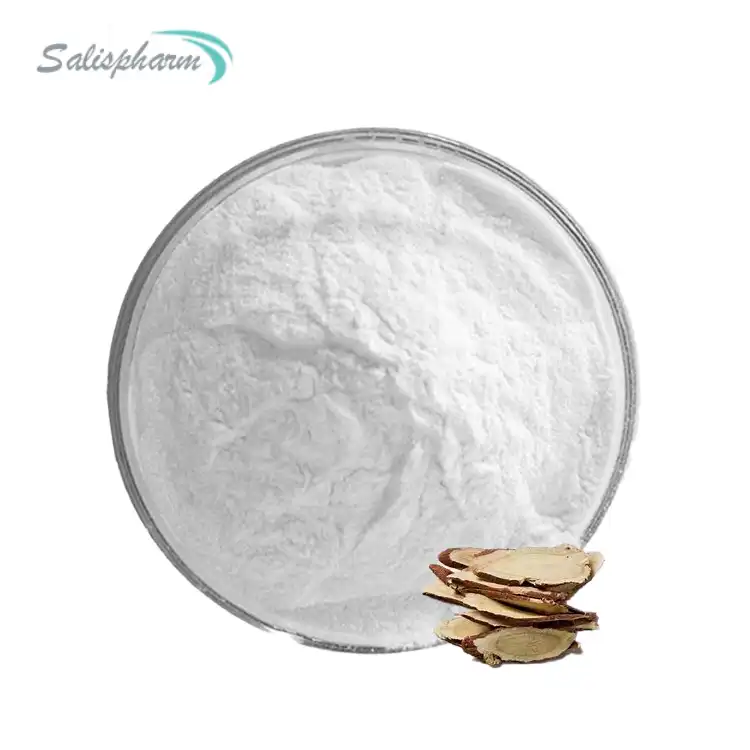Ammonium Glycyrrhizate, a compound derived from licorice root, has been gaining attention in the skincare world for its potential benefits in treating acne. This naturally occurring substance is known for its anti-inflammatory and antimicrobial properties, making it an intriguing option for those seeking alternative acne treatments. In this blog post, we'll explore the efficacy of Ammonium Glycyrrhizate in acne treatment and address some common questions surrounding its use.

How does Ammonium Glycyrrhizate work on acne-prone skin?
Ammonium Glycyrrhizate works on acne-prone skin through several mechanisms, making it a potentially effective treatment for this common skin condition. The compound's primary mode of action is its anti-inflammatory properties, which can help reduce redness, swelling, and irritation associated with acne lesions.
One of the key ways it combats acne is by inhibiting the production of pro-inflammatory cytokines. These are signaling molecules that play a crucial role in the body's inflammatory response. By suppressing their production, Ammonium Glycyrrhizate can help calm inflamed skin and reduce the severity of acne breakouts.
Additionally, it has been shown to have antimicrobial properties. This is particularly beneficial in acne treatment, as one of the primary causes of acne is the overgrowth of bacteria, specifically Propionibacterium acnes (P. acnes), on the skin. By helping to control bacterial growth, Ammonium Glycyrrhizate may prevent the formation of new acne lesions and assist in clearing existing ones.
Another interesting aspect of it is its potential to regulate sebum production. Excess sebum is a major contributor to acne development, as it can clog pores and create an environment conducive to bacterial growth. Some studies suggest that Ammonium Glycyrrhizate may help balance oil production in the skin, which could lead to fewer blocked pores and, consequently, less acne.
Furthermore, Ammonium Glycyrrhizate has been found to have skin-brightening properties. This can be particularly beneficial for those dealing with post-inflammatory hyperpigmentation, a common after-effect of acne where dark spots remain on the skin after the acne has healed. By helping to even out skin tone, Ammonium Glycyrrhizate may contribute to a more uniform complexion and improved overall skin appearance.
It's worth noting that while it shows promise in treating acne, its effectiveness can vary from person to person. Factors such as skin type, the severity of acne, and individual skin chemistry can all influence how well the compound works. As with any skincare ingredient, it's always best to consult with a dermatologist before incorporating Ammonium Glycyrrhizate into your acne treatment regimen.
What are the benefits of using Ammonium Glycyrrhizate for acne treatment?
The benefits of using Ammonium Glycyrrhizate for acne treatment are numerous and multifaceted, making it an attractive option for those seeking natural alternatives to conventional acne treatments. Let's delve into some of the key advantages this compound offers in the fight against acne.
First and foremost, Ammonium Glycyrrhizate's potent anti-inflammatory properties make it particularly effective in reducing the visible signs of acne. Inflammation is a key component of acne development, contributing to redness, swelling, and discomfort. By calming this inflammation, Ammonium Glycyrrhizate can help alleviate these symptoms, leading to clearer, less irritated skin.
Another significant benefit is its antimicrobial action. Acne is often exacerbated by the presence of bacteria on the skin, particularly P. acnes. Ammonium Glycyrrhizate's ability to inhibit bacterial growth can help prevent new acne lesions from forming and assist in clearing existing ones. This dual action of treating current breakouts while preventing future ones makes it a valuable tool in long-term acne management.
Ammonium Glycyrrhizate also shows promise in regulating sebum production. Excess sebum is a primary contributor to acne, as it can clog pores and create an environment where acne-causing bacteria thrive. By helping to balance oil production, Ammonium Glycyrrhizate may reduce the likelihood of pore blockages and subsequent acne formation.
Moreover, this compound has skin-brightening properties, which can be particularly beneficial for those dealing with post-acne hyperpigmentation. These dark spots, often left behind after acne has healed, can be as distressing as the acne itself for many individuals. Ammonium Glycyrrhizate's ability to even out skin tone can help fade these marks, contributing to a more uniform complexion.
Another advantage of Ammonium Glycyrrhizate is its potential to enhance the efficacy of other acne-fighting ingredients. Some studies suggest that it may improve the penetration of other topical treatments, allowing them to work more effectively. This synergistic effect could lead to improved overall results in acne treatment.
Importantly, Ammonium Glycyrrhizate is generally well-tolerated by most skin types. Unlike some harsh acne treatments that can cause excessive dryness or irritation, this compound tends to be gentler on the skin. This makes it a suitable option for those with sensitive skin or those who have experienced adverse reactions to other acne treatments.
Lastly, as a naturally derived compound, Ammonium Glycyrrhizate appeals to those seeking more natural or plant-based skincare solutions. While synthetic ingredients certainly have their place in skincare, many consumers appreciate having effective natural alternatives available.
Can Ammonium Glycyrrhizate be combined with other acne treatments?
Ammonium Glycyrrhizate can indeed be combined with other acne treatments, and in many cases, this combination approach can lead to enhanced results in managing acne. The versatility of this compound makes it a valuable addition to many skincare routines, working synergistically with other ingredients to provide comprehensive acne care.
One of the most common combinations is Ammonium Glycyrrhizate with salicylic acid. Salicylic acid is a beta-hydroxy acid (BHA) known for its ability to exfoliate the skin and unclog pores. When used together, Ammonium Glycyrrhizate can help soothe the skin and reduce inflammation, while salicylic acid works to clear out pores and prevent new acne formation. This combination can be particularly effective for those with oily or acne-prone skin.
Another beneficial pairing is Ammonium Glycyrrhizate with benzoyl peroxide. Benzoyl peroxide is a powerful antibacterial agent that can effectively kill acne-causing bacteria. However, it can sometimes cause dryness or irritation. Ammonium Glycyrrhizate's anti-inflammatory properties can help mitigate these side effects, making the combination more tolerable for sensitive skin types.
Retinoids, such as tretinoin or adapalene, are another class of acne treatments that can work well with Ammonium Glycyrrhizate. Retinoids promote cell turnover and help prevent clogged pores, but they can also cause initial irritation. The soothing properties of Ammonium Glycyrrhizate can help reduce this irritation, potentially improving adherence to retinoid treatments.
For those dealing with post-inflammatory hyperpigmentation, combining Ammonium Glycyrrhizate with vitamin C can be particularly beneficial. Vitamin C is known for its skin-brightening properties, and when used alongside Ammonium Glycyrrhizate, it can help fade dark spots more effectively while also providing antioxidant protection to the skin.
It's also worth noting that Ammonium Glycyrrhizate can be incorporated into a skincare routine that includes hydrating ingredients like hyaluronic acid or niacinamide. These ingredients can help maintain skin hydration and barrier function, which is crucial when using acne treatments that might otherwise dry out the skin.
When combining Ammonium Glycyrrhizate with other acne treatments, it's important to introduce new products gradually and monitor your skin's response. While Ammonium Glycyrrhizate is generally well-tolerated, everyone's skin is different, and what works for one person may not work for another. It's always advisable to consult with a dermatologist before making significant changes to your skincare routine, especially if you're dealing with persistent or severe acne.
Conclusion
Ammonium Glycyrrhizate shows great promise as an acne treatment, both on its own and in combination with other active ingredients. Its anti-inflammatory, antimicrobial, and skin-brightening properties make it a versatile addition to many acne-fighting routines. As research continues, we may discover even more benefits and effective combinations involving this natural compound, potentially revolutionizing the way we approach acne treatment.
If you are also interested in this product and want to know more product details, or want to know about other related products, please feel free to contact lea_slsbio@163.com,WhatsApp+86 13193326505.

References
1. Saeedi, M., Morteza-Semnani, K., & Ghoreishi, M. R. (2003). The treatment of atopic dermatitis with licorice gel. Journal of dermatological treatment, 14(3), 153-157.
2. Armanini, D., Fiore, C., Mattarello, M. J., Bielenberg, J., & Palermo, M. (2002). History of the endocrine effects of licorice. Experimental and Clinical Endocrinology & Diabetes, 110(06), 257-261.
3. Tolino, E., Skroza, N., Mambrin, A., Bernardini, N., Zuber, S., Balduzzi, V., & Proietti, I. (2018). Novel combination for the treatment of acne differentiated based on gender: a new paradigm in acne therapy. Dermatologic therapy, 31(6), e12757.
4. Wang, L., Yang, R., Yuan, B., Liu, Y., & Liu, C. (2015). The antiviral and antimicrobial activities of licorice, a widely-used Chinese herb. Acta Pharmaceutica Sinica B, 5(4), 310-315.
5. Shin, Y. W., Bae, E. A., Lee, B., Lee, S. H., Kim, J. A., Kim, Y. S., & Kim, D. H. (2007). In vitro and in vivo antiallergic effects of Glycyrrhiza glabra and its components. Planta medica, 73(03), 257-261.
6. Draelos, Z. D. (2019). The science behind skin care: Moisturizers. Journal of cosmetic dermatology, 18(4), 951-955.

